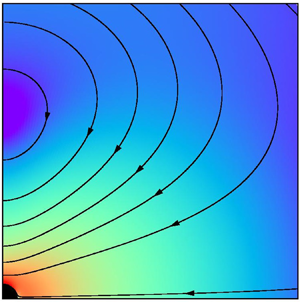Article contents
Drag and thermophoresis on a sphere in a rarefied gas based on the Cercignani–Lampis model of gas–surface interaction
Published online by Cambridge University Press: 13 August 2020
Abstract

In the present work, the influence of the gas–surface interaction law on the classical problems of viscous drag and thermophoresis on a spherical particle with high thermal conductivity immersed in a monatomic rarefied gas is investigated on the basis of the solution of a kinetic model to the linearized Boltzmann equation. The scattering kernel proposed by Cercignani and Lampis is employed to model the gas–surface interaction law via the setting of two accommodation coefficients, namely the tangential momentum accommodation coefficient and the normal energy accommodation coefficient. The viscous drag and thermophoretic forces acting on the sphere are calculated in a range of the rarefaction parameter, defined as the ratio of the sphere radius to an equivalent free path of gaseous particles, which covers the free molecular, transition and continuum regimes. In the free molecular regime the problem is solved analytically via the method of the characteristics to solve the collisionless kinetic equation, while in the transition and continuum regimes the discrete velocity method is employed to solve the kinetic equation numerically. The numerical calculations are carried out in a range of accommodation coefficients which covers most situations encountered in practice. The macroscopic characteristics of the gas flow around the sphere, namely the density and temperature deviations from thermodynamic equilibrium far from the sphere, the bulk velocity and the heat flux are calculated and their profiles as functions of the radial distance from the sphere are presented for some values of rarefaction parameter and accommodation coefficients. The results show the appearance of the negative thermophoresis in the near-continuum regime and the dependence of this phenomenon on the accommodation coefficients. To verify the reliability of the calculations, the reciprocity relation between the cross phenomena which is valid at an arbitrary distance from the sphere was found and then verified numerically within an accuracy of 0.1 %. The results for the thermophoretic force are compared to the more recent experimental data found in the literature for a copper sphere in argon gas.
- Type
- JFM Papers
- Information
- Copyright
- © The Author(s), 2020. Published by Cambridge University Press
References
REFERENCES
- 19
- Cited by


